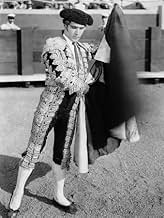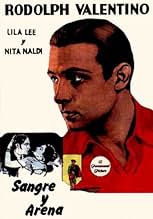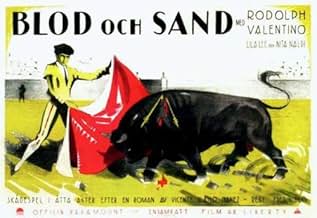NOTE IMDb
6,3/10
1,6 k
MA NOTE
Ajouter une intrigue dans votre langueA toreador's (Rudolph Valentino) familial and social life is threatened when he has an affair.A toreador's (Rudolph Valentino) familial and social life is threatened when he has an affair.A toreador's (Rudolph Valentino) familial and social life is threatened when he has an affair.
- Réalisation
- Scénario
- Casting principal
- Récompenses
- 1 victoire au total
Rudolph Valentino
- Juan Gallardo
- (as Rodolph Valentino)
Rosa Rosanova
- Angustias
- (as Rose Rosanova)
W.E. Lawrence
- Fuentes
- (as William Lawrence)
Michael Dark
- Doña Sol's New Lover
- (non crédité)
Avis à la une
"Blood and Sand" tells us many times how cruel and dangerous it believes bullfighting to be, but in terms of what it actually shows us, it seems far more interested in the romantic qualities of Rudolph Valentino and his larger-than-life love triangle.
Valentino gives a legitimately good performance, but even the love story loses some of its immediacy from the fact that "Blood and Sand" takes its subject at some distance, periodically stepping back and focusing on the scholar who foreshadows the matador's end. This also allows some of the characterization to go without being fully realized. When all is said and done it is neither believable as an anti-bullfighting film nor totally involving as a story of a love triangle, but some of the elements, including the performances and some excellent symbolic imagery, are well realized.
Valentino gives a legitimately good performance, but even the love story loses some of its immediacy from the fact that "Blood and Sand" takes its subject at some distance, periodically stepping back and focusing on the scholar who foreshadows the matador's end. This also allows some of the characterization to go without being fully realized. When all is said and done it is neither believable as an anti-bullfighting film nor totally involving as a story of a love triangle, but some of the elements, including the performances and some excellent symbolic imagery, are well realized.
Impoverished shoemaker's son Rudolph Valentino (as Juan Gallardo) wants to be a bullfighter, much to his widowed mother's dismay. Still, toreador Valentino excels in the dangerous sport; and, later, he is wealthy and famous throughout Spain. Along the way, he marries virtuous childhood sweetheart Lila Lee (as Carmen). For Valentino, temptation accompanies fame, as he falls under the spell of wicked temptress Nita Naldi (as Doña Sol), a slightly sadomasochistic bullfighting groupie. Can Valentino love two women at the same time?
Valentino performs well as an innocent ragamuffin who achieves great fame; of course, this parallels the idolization of the film's star. Moreover, the Idol proves just as attractive being seduced (herein, by Ms. Naldi) as he was the seducer (in the recent "Sheik"). Fred Niblo's "Blood and Sand" is a classic; however, the story, and disjointed bullfighting footage, do bog things down.
Great things happen, after about a quarter hour, when Valentino steps into Naldi's lair. In a neat bit of acting business, Valentino wipes a sweaty hand before greeting his seductress; then, he and Naldi's servant exchange weird looks as Valentino gets his cigarette lighted. After some crosscutting to innocent Ms. Lee, Naldi's harp-playing gets her man.
Writer June Mathis adapts well, for her star; but, the Ibáñez story should have more streamlined. Combining, or further developing, the characters played by Charles Belcher (Don Joselito) and Walter Long (Plumitas) might have helped. Mr. Belcher's character is most interesting; he collects torture devices, and choruses the film's thesis: "Happiness and prosperity built on cruelty and bloodshed cannot survive."
******* Blood and Sand (8/5/22) Fred Niblo ~ Rudolph Valentino, Lila Lee, Nita Naldi, Charles Belcher
Valentino performs well as an innocent ragamuffin who achieves great fame; of course, this parallels the idolization of the film's star. Moreover, the Idol proves just as attractive being seduced (herein, by Ms. Naldi) as he was the seducer (in the recent "Sheik"). Fred Niblo's "Blood and Sand" is a classic; however, the story, and disjointed bullfighting footage, do bog things down.
Great things happen, after about a quarter hour, when Valentino steps into Naldi's lair. In a neat bit of acting business, Valentino wipes a sweaty hand before greeting his seductress; then, he and Naldi's servant exchange weird looks as Valentino gets his cigarette lighted. After some crosscutting to innocent Ms. Lee, Naldi's harp-playing gets her man.
Writer June Mathis adapts well, for her star; but, the Ibáñez story should have more streamlined. Combining, or further developing, the characters played by Charles Belcher (Don Joselito) and Walter Long (Plumitas) might have helped. Mr. Belcher's character is most interesting; he collects torture devices, and choruses the film's thesis: "Happiness and prosperity built on cruelty and bloodshed cannot survive."
******* Blood and Sand (8/5/22) Fred Niblo ~ Rudolph Valentino, Lila Lee, Nita Naldi, Charles Belcher
I just watched the 1941 Tyrone Powers remake of this film and enjoyed it very much, and reflected on American's fascination with the corrida during a couple critical time periods. It was the perfect time to watch this Rudolph Valentino (1922) version which is also a retelling of the book by Vincente Balasco Ibanez. This is the first Valentino film that I have seen and having watched many other silent films, I can see why Valentino was such a heartthrob. He really captures your attention and unlike other stars of the era was not overly campy to get his emotions across.
The general story is still the same, poor boy aspires to be a toreador, marries girl next door, then as he achieves fame and good fortune is noticed and subsequently seduced by fickle wealthy woman...who doesn't truly care for him and moves on to her next shiny plaything, leaving our toreador Juan to pick up the pieces.
Both films end the same way...even with the concept that the bull isn't the beast but the crowd of the corrida is the never satisfied beast. I will say the 1941 film version seemed to glorify or romanticize the bullfighting much more than the 1922 version that just kind of showed it as is.
I really enjoyed this Valentino take. In fact, I think I preferred it to Tyrone Power's film. That may be an unpopular view, but there was so much packed in to the 1922 version that made it feel like you were getting a real look into the past. More emphasis was put on the story...and less on romanticizing bullfighting as a sport. So many great details gave authenticity to the scenes...like when they are in a pub it is just thick with smoke as the crowd is smoking and drinking while the Gypsies perform flamenco. In Dona Sol's seduction pad behind the action their is a small pillar with incense smoke rising above the action...have you ever thought about how smelly those homes were with no indoor plumbing, lack of bathing, etc...yep, people with money burned incense to mask the bad smells. And the mantillas! The veils, the hairstyles...someone tried to do a nice job with giving it the look and feel of Seville.
I liked the bandit character in this version with a parallel rising from poverty with bravery story.
My only complaint is the half naked house servant in Dona Sol's employ...that seemed out of place and like something you would only see in a Hollywood theatrical production.
I have read some reviews complaining of the overt seduction...but I preferred that, it gave me more sympathy for Juan who seemed to really love Carmen. In the Tyrone version...as a woman I had a lot less sympathy for Juan as it seemed like it was all instigated from him, "pretty girl must have". As a woman, I like to think men have more willpower...but maybe they don't. (Please don't burst my bubble.)
If you are a silent film fan, I think this is a must see. If you are interested in bullfighting...I think this is a worthy watch and if you are interested in the 1920's you should definitely watch this. Highly recommend.
The general story is still the same, poor boy aspires to be a toreador, marries girl next door, then as he achieves fame and good fortune is noticed and subsequently seduced by fickle wealthy woman...who doesn't truly care for him and moves on to her next shiny plaything, leaving our toreador Juan to pick up the pieces.
Both films end the same way...even with the concept that the bull isn't the beast but the crowd of the corrida is the never satisfied beast. I will say the 1941 film version seemed to glorify or romanticize the bullfighting much more than the 1922 version that just kind of showed it as is.
I really enjoyed this Valentino take. In fact, I think I preferred it to Tyrone Power's film. That may be an unpopular view, but there was so much packed in to the 1922 version that made it feel like you were getting a real look into the past. More emphasis was put on the story...and less on romanticizing bullfighting as a sport. So many great details gave authenticity to the scenes...like when they are in a pub it is just thick with smoke as the crowd is smoking and drinking while the Gypsies perform flamenco. In Dona Sol's seduction pad behind the action their is a small pillar with incense smoke rising above the action...have you ever thought about how smelly those homes were with no indoor plumbing, lack of bathing, etc...yep, people with money burned incense to mask the bad smells. And the mantillas! The veils, the hairstyles...someone tried to do a nice job with giving it the look and feel of Seville.
I liked the bandit character in this version with a parallel rising from poverty with bravery story.
My only complaint is the half naked house servant in Dona Sol's employ...that seemed out of place and like something you would only see in a Hollywood theatrical production.
I have read some reviews complaining of the overt seduction...but I preferred that, it gave me more sympathy for Juan who seemed to really love Carmen. In the Tyrone version...as a woman I had a lot less sympathy for Juan as it seemed like it was all instigated from him, "pretty girl must have". As a woman, I like to think men have more willpower...but maybe they don't. (Please don't burst my bubble.)
If you are a silent film fan, I think this is a must see. If you are interested in bullfighting...I think this is a worthy watch and if you are interested in the 1920's you should definitely watch this. Highly recommend.
Most people picture Rudolph Valentino from his earlier roles in "Four Horsemen Of The Apocalypse" or "The Sheik". In this movie, Valentino plays a Matador in Spain and the story traces his rise and fall. Yes, he certainly was handsome and you see traces of his definate appeal here. For me, though, the movie was stolen by "the other woman", Dona Sol. She tarts her role up real well and plays it very broad, almost shockingly brazen for it's time. The scene where she tells Valentino that she longs to fell him beat her will make us wince, then she bites his hand while while in a semi-embrace in order to raise his passions. All stuff that seems pretty extreme for the typical innocent silent movie woman roles. The ending will be no surprise, it is telegraphed and alluded to many times during the movie. It's not Rudy at his absolute best, but I can recommend it.
You know the story even if you've never heard of this movie: young man becomes famous and starts cheating on his wife. Good characterizations and vivid backgrounds can't save the tired (even for its time) plot. Bullfighting scenes are more curious than exciting. Director Niblo's talents do not shine as brightly as in Ben-Hur 3 years later. The 1941 remake is better.
Le saviez-vous
- AnecdotesThe film's editor was Dorothy Arzner, who would later go on to become Hollywood's first female director. Arzner impressed the producers by cannily interspersing stock bull-fighting footage with shots of Rudolph Valentino to make it look like the actor was actually in the ring with real bulls. This was quite a progressive technique in its day.
- GaffesThe mountain bandit who is one of the principal supporting characters is an anachronism; the Guardia Civil did away with their kind during the late 19th century.
- Citations
Juan Gallardo: We spread our capes for your amusement and most generous alms.
- ConnexionsEdited into Michael Blanco (2004)
Meilleurs choix
Connectez-vous pour évaluer et suivre la liste de favoris afin de recevoir des recommandations personnalisées
- How long is Blood and Sand?Alimenté par Alexa
Détails
Box-office
- Montant brut aux États-Unis et au Canada
- 2 725 000 $US
- Durée
- 1h 48min(108 min)
- Mixage
- Rapport de forme
- 1.33 : 1
Contribuer à cette page
Suggérer une modification ou ajouter du contenu manquant





































